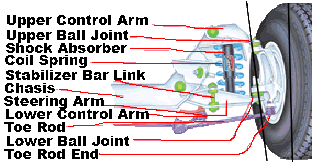 KPI and included angle basics KPI and included angle basics
K.P.I - kingpin inclination,
S.A.I - swivel arm inclination,
B.J.I - ball joint inclination,
The kpi is the angle formed between the true vertical, and the centre line through the ball joints or struts, the term kpi is no longer relevant since it is reliant on older forms of construction, in fact, as far back as the horse and cart, the evolution of new technology forming the cars geometry, commanded new terminology such as S.A.I and B.J.I, my preference is K.P.I as this term is recognized globally,
The kpi is designed into the suspension system and is there to aid keeping the wheels straight, and to aid self centring of the steering, to understand how this is achieved, it is necessary to imagine a system with 0 degree kpi.

As there is a resistance between the tyre and the road surface, this makes the wheel want to turn around ( in this case ) the upper and lower swivel joints, with equal force on the front tyres, this results in a force that tries to compress the steering rack.
As these forces are equal both sides of the vehicle should not deviate from straight ahead, if for instance one wheel hits a bump then the two forces would not be equal, this would cause the driver to correct this force by turning the steering wheel, The wheel that hits the bump will have a greater turning action around the upper and lower swivel joints, so to control the directional stability of the vehicle, the inclination of the upper and lower swivel joints must have an equal addition and subtraction to their inclination, in addition, the wheels camber angle on compression will equal the loss of the inclination, so guaranteeing a couple between the inclined and declined kpi,
Summary
KPI
-Provides steering pivot near to the tyres centre line,
-reduces steering effort,
-aids directional control,
-aids self centring of the steering,
-helps to distribute vehicle weight evenly across the tyre,
Included Angle
The included angle is an angle measured in degrees, and is generated as a result of adding the sum of the camber angle, when positive, to the sum of the kingpin inclination, and subtracting the sum of the camber angle when negative, from the sum of the kingpin inclination,
Since both the kingpin inclination, and the included angle, are perpendicular to the vertical, as seen from the front of the vehicle, there is a couple between the two angles that determine the point of load that is distributed across the contact point of the tyre (scrub radius),
It can be said that the included angle is used as a form of diagnostics, to determine if there is damage to the frame supporting the directional wheels geometry, and if the included angle is adding or subtracting, a value to the scrub radius, concluding whether this weight of the vehicle is distributed evenly across the tyre, or is adding weight to the inner, or outer edges, causing, adverse or uneven wear.
|